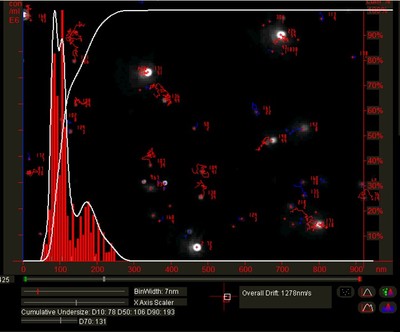The University of Melbourne boosts its toolkit for nanoparticle analysis with the Malvern NanoSight NS300

The Malvern NanoSight NS300, recently installed within the Materials Characterisation and Fabrication Platform (MCFP) at the University of Melbourne, is providing an easy-to-use, reproducible platform for nanoparticle characterisation.
Aimed to support cutting-edge research in fields such as nanobiotechnology, biomedical engineering and drug delivery, the instrument is now available for all academic researchers and external commercial work.
“The instrument is already being used by researchers from various disciplines and backgrounds including academic, research institution and industrial users,” said James Griffith, Acting Platform Manager, MCFP. The range of samples being analysed includes gold nanoparticles, nanoparticles within biological mediums, polymers and extracellular vesicles.
The MCFP supports materials research through advanced instrumentation, analysis and characterisation. The MCFP hosts a number of complementary techniques for particle characterisation, including the recently installed NanoSight NS300. The MCFP welcomes all users across the scientific community.
“We decided to purchase a NanoSight to have an instrument that combines the capabilities of multiple instruments in one in order to look at particle concentration and size distribution,” said Griffith. “The ease of use and rapid analysis makes the instrument convenient for researchers of all levels and from a broad range of disciplines.”

Nanoparticle size analysis
Nanoparticles are playing a growing role across a range of different applications and industries due to their unique properties, such as high surface area to volume and high number. Applications such as viral vaccines, nanobubbles, exosomes, coatings, filtration and the ability to remove pollutants from industrial processes all require an understanding of the different nanoparticle properties to optimise their stability and effectiveness.
There are many techniques available for analysis of nanoparticle size distribution, of which the most common include dynamic light scattering (DLS), electron microscopy (EM), atomic force microscopy (AFM) and analytical ultracentrifugation (AUC). Although EM and AFM offer information related to particle morphology and size, they can be time-consuming and require a certain degree of previous knowledge of the composition of the material.
Particle size combined with particle light scattering for visual validation
Nanoparticle tracking analysis (NTA) is a relatively new technique based on well-understood principles of sizing. It uses the properties of both light scattering and Brownian motion to characterise individual nanoparticles.
NTA offers the unique capability to visualise, size and count individual nanoparticles in liquid suspension in real time. It is suited for polydispersed systems ranging from 10–30 nm up to 1–2 µm in size (depending on particle type) and is particularly useful for very dilute dispersions. Additional parameters also allow users to acquire information on nanoparticle concentration, relative intensity of light scattered and also to visualise and analyse fluorescently labelled particles.
The NTA technique captures images of the sample particles undergoing Brownian motion in a liquid and obtains size and concentration information using frame-by-frame video image analysis. By measuring the speed of Brownian motion of particles, the nanoparticle diffusion constant can be determined, from which a spherical hydrodynamic diameter can be estimated.

As NTA allows nanoparticles to be simultaneously tracked and analysed on an individual basis, the resulting data is a high resolution particle size distribution analysis in which different materials can be distinguished through their different scattering intensities and, importantly, from which particle concentration can be recovered. As well as particle size distribution and concentration, protein aggregation and viscosity can all be analysed. The unique feature of direct visualisation of the suspension gives the user extra confidence while a fluorescence mode provides detection of labelled particles.
“The fluorescent labelling capability is important for us, and the ability to actually visualise the nanoparticles on a user-friendly interface of NTA software is popular with users,” said Griffith.
The NTA technique is fast, robust, accurate and low cost, representing an attractive complement to existing methods of nanoparticle analysis such as DLS or EM.
ISO standard ISO19430
The ASTM E2834–12 method was developed to give guidance to the measurement of particle size distribution by means of NTA. In December 2016, the publication of the long-awaited international standard (ISO19430) particle tracking analysis (PTA) method broadened the scope of the specification. The ISO standard describes the evaluation of the number-based particle size distribution in liquid dispersions (solid, liquid or gaseous particles suspended in liquids) using the particle tracking analysis method for diffusion velocity measurements. The Malvern NanoSight meets all the key deliverables for the new ISO standard and is an essential tool in the lab of the modern scientist.
Booking the NanoSight
The Malvern NanoSight NS300 at the MCFP lab is available for independent use by trained students and staff and is booked on an hourly basis. To become a lab user or to enquire about training, fee-for-service, consultancy work or any other information, contact Paul Brannon (paul.brannon@unimelb.edu.au). ATA Scientific continues to support customers throughout Australia and New Zealand as it has for more than 27 years. Our dedicated local service team have a long history of providing excellent customer service and support. For more information on the Malvern NanoSight or any other particle characterisation tools, please contact us.
ATA Scientific Pty Ltd
+61 2 9541 3500
enquiries@atascientific.com.au
www.atascientific.com.au
Burkert Microsensors: Precision and Partnership for Critical Laboratory and Medical Applications
Burkert microsensors are engineered for seamless integration into laboratory and medical devices,...
Safeguarding Cryopreservation: When Failure Is Not an Option
Vaisala's viewLinc Continuous Monitoring System was developed with high-stakes applications...
World First — Clever Engineering and Flexible Technology Solves a Nanoparticle Challenge
It is not every day that you get to solve a unique problem. But that's exactly what happened...





